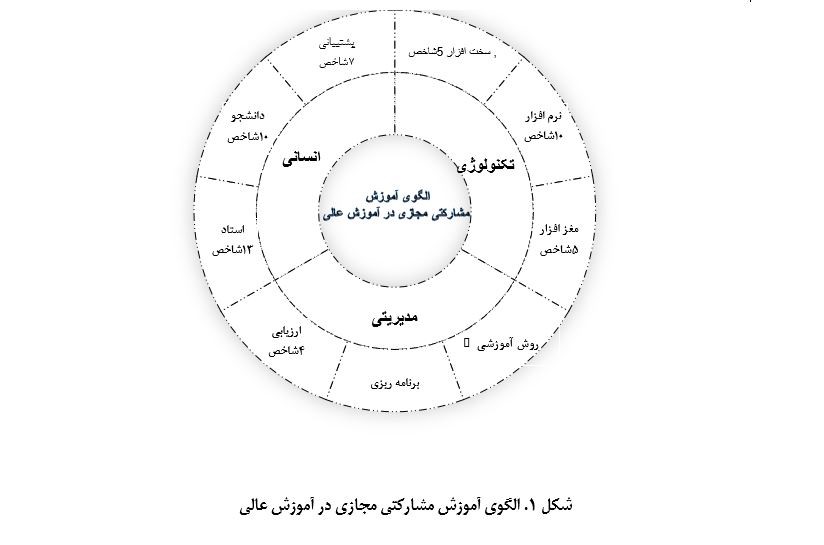Providing a Model for Collaborative Learning in Virtual Environments (Case Study: Islamic Azad Universities in Tehran)
Keywords:
Model, learning, virtual space, collaborativeAbstract
The aim of this study is to design a model for collaborative learning in virtual environments, specifically focusing on the Islamic Azad Universities in Tehran. The research is applied in terms of its goal, employs qualitative data, and is exploratory in nature, based on a grounded theory approach. The study population consists of experts, and 15 experts were selected for interviews through theoretical sampling of the snowball type, based on theoretical data saturation. A semi-structured interview was used as the research tool, organizing the dimensions, components, and indicators of the collaborative learning model in virtual environments. Initially, several models, findings, studies, and national and global theories were reviewed to create the interview form. Subsequently, open coding was used to identify indicators, and axial coding categorized them into dimensions, components, and indicators, which were then sent to the 15 experts. Through selective coding, interviews, the Delphi method, and brainstorming, the dimensions and components were identified. As a result, three dimensions, nine components, and 62 indicators for the virtual collaborative learning model were finalized. Following the experts' final validation and prioritization, the model's dimensions, components, and indicators were mapped, and the model was re-validated by experts.
Downloads
References
Xue L, Rienties B, Van Petegem W, Van Wieringen A. Learning relations of knowledge transfer (KT) and knowledge
integration (KI) of doctoral students during online interdisciplinary training: an exploratory study. Higher Education Research
& Development. 2020:1-18.
Cole PG. Use of online collaborative learning strategy in enhancing postgraduates' learning outcomes in science
education. Educational Research and Reviews. 2020;15(8):504-10.
Puri AK. E-learning system use and its outcomes: Moderating role of perceived compatibility. Telematics and
Informatics. 2016;33(1):48-55.
Sarafizadeh A. Information Technology in Organizations (IT). Tehran: Mir Publications; 2021.
Abdul Munem HAA, Husam Abdulhameed H, Ashraf Kamil R, Dayef OM. Cloud computing application and its
advantages and difficulties in the teaching process. Journal of International Teaching Management. 2019;11(3):82-98.
Hafezi A, Mofakhami A, Basharatnia MS. The Importance and Role of Strategic Planning in Implementing E-learning
in Higher Education. New Approaches in Educational Sciences. 2021(9):39-47.
Ahmadi S, Abbaszadeh Y, Ghahramani J. Presenting a Model for the E-learning System in Higher Education
Institutions. Leadership and Educational Management. 2021(55):137-64.
Khademi Y, Sadr a-D, Sattari. Evaluation and Prioritization of Types of Interaction and Participation in the E-learning
Environment Using the Analytical Hierarchy Process (AHP) Technique. Information and Communication Technology in
Educational Sciences. 2021(43):87-108.
Nooijer Jd, Schneider F, Verstegen DML. Optimizing collaborative learning in online courses. 2020.
Turugare M, Rudhumbu N. Integrating technology in teaching and learning in universities in Lesotho: opportunities
and challenges. Education and Information Technologies. 2020;25:3593-612.
Enayati Novinfar A, Seraji F, Gholamali M. Evaluation and Measurement Studies in Education: Presenting a Model
for Implementing a Virtual Curriculum Based on the Collaborative Learning Approach in Higher Education. Evaluation and
Educational Measurement Studies. 2018;8(23):117-52.
Taylor DCM, Hamdy H. Adult learning theories: Implications for learning and. 2018.

Downloads
Published
Submitted
Revised
Accepted
Issue
Section
License
Copyright (c) 2024 Journal of Study and Innovation in Education and Development

This work is licensed under a Creative Commons Attribution-NonCommercial 4.0 International License.










